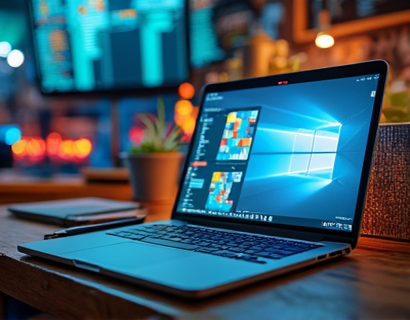Advanced Smart-Contract Technology for Seamless Token Management Pegged to UCASH and U Assets
In the rapidly evolving landscape of blockchain and cryptocurrency, the management of digital tokens has become a critical aspect for users and developers alike. Traditional methods of token management often involve complex processes, potential security risks, and inefficiencies. However, with the advent of advanced smart-contract technology, token management has transformed into a seamless, secure, and efficient experience. This article delves into how smart-contract technology optimizes token management, particularly for tokens pegged to UCASH and other U assets, ensuring a robust integration with leading cryptocurrencies and digital assets.
The foundation of this advanced token management system lies in the implementation of sophisticated smart contracts. Smart contracts are self-executing contracts with the terms of the agreement directly written into code. These contracts run on blockchain networks, which provide a decentralized, transparent, and immutable ledger. By leveraging smart contracts, token management becomes automated, reducing the need for intermediaries and minimizing human error.
Enhanced Security Through Smart Contracts
One of the primary advantages of using smart contracts for token management is the enhanced security they offer. Traditional token management systems often rely on centralized servers, making them vulnerable to hacks and data breaches. In contrast, smart contracts execute on blockchain networks, which are inherently secure due to their decentralized nature. Each transaction is verified by multiple nodes in the network, ensuring that no single point of failure exists.
Moreover, smart contracts are immutable once deployed, meaning that once the code is written and verified, it cannot be altered. This immutability ensures that the rules governing token issuance, distribution, and redemption are fixed and transparent, reducing the risk of fraudulent activities. For users managing tokens pegged to UCASH and other U assets, this means their tokens are protected against unauthorized changes and manipulations.
Efficiency in Token Management
Efficiency is another key benefit of using advanced smart-contract technology for token management. Traditional methods often involve multiple steps and intermediaries, such as exchanges and custodians, which can lead to delays and increased costs. Smart contracts automate these processes, allowing for instantaneous and direct transactions between parties. This not only speeds up the management of tokens but also reduces transaction fees and operational costs.
For instance, when managing tokens pegged to UCASH, smart contracts can automatically adjust the token value based on the underlying UCASH price in real-time. This ensures that the token remains accurately pegged without the need for manual interventions. Such automation is crucial for maintaining the integrity and reliability of the token, especially in fast-moving markets.
Seamless Integration with Leading Cryptocurrencies
The advanced smart-contract technology used in token management systems is designed to seamlessly integrate with leading cryptocurrencies and digital assets. This integration is achieved through standardized protocols and interfaces, such as ERC-20 for Ethereum-based tokens and BEP-20 for Binance Smart Chain tokens. These standards ensure compatibility and interoperability across different blockchain platforms.
For users holding a variety of cryptocurrencies, this means they can manage all their tokens from a single, unified platform. The smart contracts can interact with multiple blockchain networks, allowing for cross-chain transactions and asset transfers. This level of integration not only simplifies the user experience but also opens up new possibilities for decentralized finance (DeFi) applications and composite assets.
Token Pegging and Stability
Token pegging to UCASH and other U assets is a critical feature that ensures the stability and value of the tokens. A pegged token maintains a fixed value relative to the underlying asset, providing users with a stable store of value and a reliable medium of exchange. Advanced smart-contract technology facilitates this pegging process by continuously monitoring the underlying asset's price and adjusting the token supply accordingly.
For example, a token pegged to UCASH would have its supply dynamically adjusted to maintain a 1:1 ratio with the UCASH price. If the UCASH price increases, the smart contract would automatically reduce the number of tokens in circulation to maintain the peg. Conversely, if the UCASH price decreases, the contract would increase the token supply. This mechanism ensures that the token remains a stable and trustworthy asset.
User Control and Transparency
Another significant advantage of using smart contracts for token management is the level of control and transparency they provide to users. Users have full access to the smart contract's code, allowing them to verify the rules and parameters governing their tokens. This transparency builds trust and confidence among users, as they can independently audit the system.
Additionally, smart contracts enable users to set custom rules and conditions for token management. For instance, users can define specific events that trigger certain actions, such as automatic token redemption or distribution based on predefined metrics. This level of customization ensures that the token management system aligns with the specific needs and goals of the users.
Scalability and Flexibility
Advanced smart-contract technology is not only secure and efficient but also highly scalable and flexible. As the demand for token management grows, the system can easily scale to handle a larger number of users and transactions without compromising performance. The decentralized nature of blockchain ensures that the system can handle increased load by distributing the computational tasks across multiple nodes.
Flexibility is another key feature, as smart contracts can be updated and modified to accommodate new requirements or changes in the underlying assets. This adaptability ensures that the token management system remains relevant and effective over time, even as market conditions and user needs evolve.
Case Studies and Real-World Applications
To better understand the practical applications of advanced smart-contract technology in token management, let's consider a few real-world scenarios. One notable example is the use of stablecoins pegged to fiat currencies like UCASH. These stablecoins are essential for decentralized finance applications that require price stability to function effectively.
In one case, a decentralized lending platform integrated smart contracts to manage stablecoins pegged to UCASH. The smart contracts automatically adjusted the token supply based on the UCASH price, ensuring that the stablecoins remained a reliable store of value for borrowers and lenders. This integration not only enhanced the platform's credibility but also attracted more users who valued the stability and security of the tokens.
Another application is in the realm of decentralized exchanges (DEXs). DEXs use smart contracts to facilitate peer-to-peer trading of tokens without the need for a central authority. By pegging tokens to UCASH and other U assets, DEXs can offer users a wider range of trading pairs with stable value propositions, reducing the volatility risks associated with traditional cryptocurrencies.
Future Prospects and Innovations
The future of token management through advanced smart-contract technology is promising, with several innovations on the horizon. One area of development is the integration of machine learning and artificial intelligence to enhance the smart contract's decision-making capabilities. These technologies can analyze market data and user behavior to optimize token management strategies, further improving efficiency and user experience.
Another exciting development is the creation of multi-asset tokens that can be pegged to multiple underlying assets simultaneously. This would allow users to manage a diversified portfolio of tokens with a single smart contract, simplifying the management process and reducing the complexity of holding multiple contracts.
Additionally, the emergence of layer 2 solutions and interoperability protocols will further enhance the scalability and cross-chain capabilities of smart-contract-based token management systems. These advancements will enable seamless token transfers and interactions across different blockchain ecosystems, opening up new opportunities for decentralized applications and services.
In conclusion, advanced smart-contract technology is revolutionizing token management by providing enhanced security, efficiency, and user control. By leveraging the power of blockchain and smart contracts, users can manage their tokens pegged to UCASH and other U assets with confidence and ease. As the technology continues to evolve, the potential for innovation and improvement in the financial ecosystem is vast, paving the way for a more decentralized and user-centric future.










































